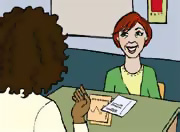What should Ms. Milton consider when creating lesson plans to ensure the inclusion of Evan and Emily?
Page 5: Educational Materials

Before school began, Ms. Milton spent a lot of time preparing group-oriented, hands-on activities for her students, and was very excited about implementing them. Now, however, she wonders whether Evan and Emily will be able to participate in all of these activities. Ms. Milton must realize that it is perfectly reasonable for her to expect Evan and Emily to participate in the lessons and activities that she has prepared, as long as she is willing to make changes to the educational materials that she plans to use.
The TVI is usually the person responsible for making changes to instructional materials to ensure that students with visual disabilities have full access to the content presented in class. It is critical that the general education teacher work closely with the teacher of visual impairments. The TVI will assess each student with a visual impairment to make individual determinations about which accommodations for instructional materials will be most appropriate. The teacher and the TVI should develop a plan for when and how the teacher will provide the lesson materials to the TVI so that he or she can make the necessary changes. It is important to ensure that the TVI will have enough lead-time to make or otherwise obtain the appropriate materials. It is also important to keep in mind that some types of material alterations may require more time than others.
Listen as Anne Corn discusses the importance of collaboration between the general education teacher and the TVI.

Transcript: Anne Corn, EdD
What’s most important is plan ahead and work with the teacher of students with visual impairments to be sure that the child is ready to access the lessons that you’re going to be able to provide for all the children in your classroom. So, for example, if you’re going to be teaching children how to tell time, be sure that the child has an embossed wristwatch or a clock that they can use. If you’re going to be talking about eclipse of the sun, be sure that the child has the prerequisite skills, such as understanding concepts of light and shadow. Prepare ahead of time so that the materials that you need are made available in braille or recorded form or whatever is going to help you teach that child because this child is a child in your classroom, along with all the other children.
The changes the TVI usually makes are referred to as accommodations. An accommodation is an alteration to the material (e.g., an assignment, a test) that helps a student to fully access the standard curriculum and demonstrate what he or she has learned. For example, Ms. Milton can ask the TVI to enlarge her classroom handouts to accommodate Emily’s needs.
Instructional Materials
Accommodations may be made to allow students access to instructional materials through the visual, tactile, or auditory senses. The type of accommodations made will be determined by the TVI (based on information and recommendations in the IEP) and will vary depending on the needs of the individual student.
 Visual
Visual
The purpose of visual accommodations is to enlarge print materials, to increase the contrast and clarity of print materials, or to decrease glare and visual clutter to make items easier to view. The teacher can make these changes directly to the materials or students can achieve the changes using devices in class.
Examples:
- Enlarged or high-contrast print materials (e.g., text, handouts, pictures, graphs, diagrams)
- High-contrast writing supplies (e.g., dark felt-tip pens for the student to use when completing assignments or for others to use when creating written materials for the student)
- Contrast-enhancing aids (e.g., colored acrylic sheets that can be laid over print materials)
- Large-print text books and materials (e.g., handouts, worksheets)
- Magnified materials (e.g., using devices such as a closed-circuit television (CCTV) or hand-held magnifiers)
- Increased proximity to print materials (e.g., using devices such as reading stands)
- Additional task lighting
- Glare-reduction devices (e.g., sunglasses or visors indoors)
One can also reduce visual clutter on handouts by providing plenty of space between pictures or words, limiting the use of unnecessary graphics, and putting fewer items and less text on a page. The same considerations can be used for overhead presentations and chalkboard information.
 Tactile
Tactile
Typically made for students like either Evan or Emily (who are blind or who have low vision), these accommodations allow for access to print materials and enable students who are blind to learn about their environment.
Examples:
- Transcribing print materials (e.g., text, handouts, tests) into braille
- Making tactile representations (e.g., with raised lines or raised dots) of maps, graphs, diagrams, and simple pictures
- Using three-dimensional models (e.g., model trains, human skeletal systems, models of the human eye)
- Providing actual hands-on experiences with real objects versus providing pictures or toys (e.g., using real fruits instead of pictures or toy fruits)
One can also reduce visual clutter on handouts by providing plenty of space between pictures or words, limiting the use of unnecessary graphics, and putting fewer items and less text on a page. The same considerations can be used for overhead presentations and chalkboard information.
 Auditory
Auditory
In addition to visual or tactile materials, some students with visual impairments may benefit from materials provided in an auditory format. Holbrook and Koenig (2002) suggest, however, that careful consideration of the use of auditory materials is needed. Teachers should maintain a balance between the use of auditory materials and print or braille materials, so that the development of reading and writing skills won’t be compromised.
Examples:
- Books on audio-tape or in an electronic format (e.g., a computer with speech synthesizer software)
- Teacher-made tape recordings of handouts or text materials
- Student tape-recorded responses to assignments or test questions
- Audio descriptions of visual information presented on videos by the teacher, aide, or classmates
- Descriptive videos (i.e., videos that have narrated descriptions of the visual content), versions of which are available for several commercial movies
Assignments and Tests
Evan’s and Emily’s IEPs will indicate the accommodations to assignments and tests that they may require. The TVI will be the primary resource for assisting Ms. Milton in making these accommodations as needed. The type of accommodations implemented will vary depending on individual students’ needs and may include any or all of the following:
 SETTING |
 TIMING |
 SCHEDULING SCHEDULING |
 PRESENTATION PRESENTATION |
 RESPONSE RESPONSE |
| Change the location; for example, allow the student to go to a quieter or better lit room. | Allow the student extended time or to take frequent breaks. | Schedule only during a specific time, such as when the TVI is available to act as a scribe. | Change the format or the presentation of materials; for example, use large print or an assistive device such as a computer. | Change how the student responds; for example, allow a recorded response. |